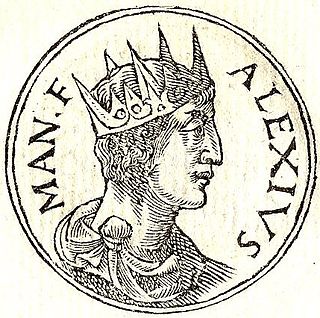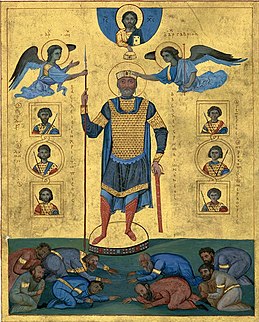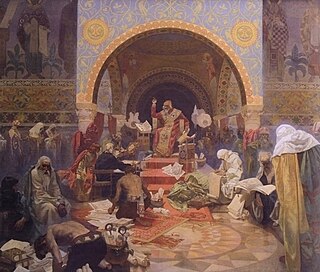
Alexios II Komnenos or Alexius II Comnenus was Byzantine emperor from 1180 to 1183. He was the son of Emperor Manuel I Komnenos and Maria, daughter of Raymond of Poitiers, prince of Antioch. He was the long-awaited male heir and was named Alexius as a fulfilment of the AIMA prophecy.

Alexios III Angelos was Byzantine Emperor from March 1195 to July 17/18, 1203. A member of the extended imperial family, Alexios came to throne after deposing, blinding, and imprisoning his younger brother Isaac II Angelos. The most significant event of his reign was the attack of the Fourth Crusade on Constantinople in 1203, on behalf of Alexios IV Angelos. Alexios III took over the defense of the city, which he mismanaged, then fled the city at night with one of his three daughters. From Adrianople, and then Mosynopolis, he unsuccessfully attempted to rally his supporters, only to end up a captive of Marquis Boniface of Montferrat. He was ransomed, sent to Asia Minor where he plotted against his son-in-law Theodore Laskaris, but was eventually arrested and spent his last days confined to the Monastery of Hyakinthos in Nicaea, where he died.
An emperor is a monarch, and usually the sovereign ruler of an empire or another type of imperial realm. Empress, the female equivalent, may indicate an emperor's wife, mother, or a woman who rules in her own right. Emperors are generally recognized to be of a higher honour and rank than kings. In Europe, the title of Emperor has been used since the Middle Ages, considered in those times equal or almost equal in dignity to that of Pope due to the latter's position as visible head of the Church and spiritual leader of the Catholic part of Western Europe. The Emperor of Japan is the only currently reigning monarch whose title is translated into English as Emperor.

The Roman emperor was the ruler of the Roman Empire during the imperial period. The emperors used a variety of different titles throughout history. Often when a given Roman is described as becoming "emperor" in English, it reflects his taking of the title Augustus or Caesar. Another title often used was imperator, originally a military honorific. Early Emperors also used the title princeps. Emperors frequently amassed republican titles, notably princeps senatus, consul and pontifex maximus.

The Latin word imperator derives from the stem of the verb imperare, meaning 'to order, to command'. It was originally employed as a title roughly equivalent to commander under the Roman Republic. Later it became a part of the titulature of the Roman Emperors as part of their cognomen. The English word emperor derives from imperator via Old French Empereür. The Roman emperors themselves generally based their authority on multiple titles and positions, rather than preferring any single title. Nevertheless, imperator was used relatively consistently as an element of a Roman ruler's title throughout the principate and the dominate. In Latin, the feminine form of Imperator is imperatrix.

The Byzantine Empire had a complex system of aristocracy and bureaucracy, which was inherited from the Roman Empire. At the apex of the hierarchy stood the emperor, yet "Byzantium was a republican absolute monarchy and not primarily a monarchy by divine right". Beneath the emperor, a multitude of officials and court functionaries operated the complex administrative machinery that was necessary to run the empire. In addition to those officials, a large number of honorific titles existed, which the emperor awarded to his subjects or to friendly foreign rulers.

Third Rome is the hypothetical successor of ancient Rome. Second Rome usually refers to Constantinople, the capital of the Byzantine Empire, unofficially called "New Rome", or one of the claimed successors to the Western Roman Empire such as the Papal States and the Holy Roman Empire.

Isaac Komnenos or Comnenus, ruled Cyprus from 1184 to 1191, before Richard the Lionheart, King of England conquered the island during the Third Crusade.
Komnenos, Latinized Comnenus, plural Komnenoi or Comneni, is a noble family who ruled the Byzantine Empire from 1081 to 1185, and later, as the Grand Komnenoi founded and ruled the Empire of Trebizond (1204–1461). Through intermarriages with other noble families, notably the Doukai, Angeloi, and Palaiologoi, the Komnenos name appears among most of the major noble houses of the late Byzantine world.
Sebastos was an honorific used by the ancient Greeks to render the Roman imperial title of Augustus. The female form of the title was sebastē (σεβαστή). From the late 11th century on, during the Komnenian period, it and variants derived from it, like sebastokrator, protosebastos, panhypersebastos, and sebastohypertatos, formed the basis of a new system of court titles for the Byzantine Empire.
Isaac Komnenos or Comnenus, was the third son of Byzantine Emperor John II Komnenos by Irene of Hungary. He was bypassed by his father in favour of his younger brother Manuel I Komnenos for the succession, leading to a tense relationship between the two brothers after. He participated in the campaigns of his father and brother in Asia Minor, and was a fervent adherent of Patriarch Cosmas II of Constantinople, but little else is known about his life.
Nikephoros Melissenos, Latinized as Nicephorus Melissenus, was a Byzantine general and aristocrat. Of distinguished lineage, he served as a governor and general in the Balkans and Asia Minor in the 1060s. In the turbulent period after the Battle of Manzikert in 1071, when several generals tried to seize the throne for themselves, Melissenos remained loyal to Michael VII Doukas and was exiled by his successor Nikephoros III Botaneiates. In 1080–1081, with Turkish aid, he seized control of what remained of Byzantine Asia Minor and proclaimed himself emperor against Botaneiates. After the revolt of his brother-in-law Alexios I Komnenos, however, which succeeded in taking Constantinople, he submitted to him, accepting the rank of Caesar and the governance of Thessalonica. He remained loyal to Alexios thereafter, participating in most Byzantine campaigns of the period 1081–1095 in the Balkans at the emperor's side. He died on 17 November 1104.

Augustus was an ancient Roman title given as both name and title to Gaius Octavius, Rome's first Emperor. On his death, it became an official title of his successor, and was so used by Roman emperors thereafter. The feminine form Augusta was used for Roman empresses and other females of the Imperial family. The masculine and feminine forms originated in the time of the Roman Republic, in connection with things considered divine or sacred in traditional Roman religion. Their use as titles for major and minor Roman deities of the Empire associated the Imperial system and Imperial family with traditional Roman virtues and the divine will, and may be considered a feature of the Roman Imperial cult.
Nobilissimus, in Byzantine Greek nōbelissimos, was one of the highest imperial titles in the late Roman and Byzantine empires. The feminine form of the title was nobilissima.
The title of protosebastos was a high Byzantine court title created by Emperor Alexios I Komnenos.
Sebastokrator, was a senior court title in the late Byzantine Empire. It was also used by other rulers whose states bordered the Empire or were within its sphere of influence. The word is a compound of "sebastos" and "krátor". The wife of a Sebastokrator was named sebastokratorissa in Greek or sevastokratitsa (севастократица) in Bulgarian and sevastokratica (севастократица) in Serbian.

Tsar, also spelled czar, or tzar, is a title used to designate East and South Slavic monarchs or supreme rulers of Eastern Europe, originally Bulgarian monarchs from 10th century onwards. As a system of government in the Tsardom of Russia and the Russian Empire, it is known as Tsarist autocracy, or Tsarism. The term is derived from the Latin word Caesar, which was intended to mean "Emperor" in the European medieval sense of the term—a ruler with the same rank as a Roman emperor, holding it by the approval of another emperor or a supreme ecclesiastical official —but was usually considered by western Europeans to be equivalent to king, or to be somewhat in between a royal and imperial rank.
Andronikos Doukas Angelos was a Byzantine aristocrat related to the ruling Komnenos dynasty. During the reign of his cousin, Manuel I Komnenos, he served without success as a military commander against the Seljuk Turks, and as envoy to the Kingdom of Jerusalem. Following Manuel's death, in 1182 he was sent to stop the rebellion of Andronikos I Komnenos, but was defeated and eventually defected to him. Shortly after, he led a failed conspiracy of leading aristocrats against Andronikos I. When it was discovered, Andronikos and his sons fled the Empire, ending up in Acre, where he died. He was the father of emperors Isaac II Angelos and Alexios III Angelos.



















